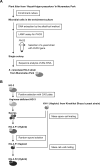Screening using loop-mediated isothermal amplification (LAMP) assay and breeding of a Saccharomyces cerevisiae strain isolated from Muramatsu Park, Japan, for sake brewing
- PMID: 39493653
- PMCID: PMC11527770
- DOI: 10.47371/mycosci.2024.04.002
Screening using loop-mediated isothermal amplification (LAMP) assay and breeding of a Saccharomyces cerevisiae strain isolated from Muramatsu Park, Japan, for sake brewing
Abstract
Sake is a Japanese alcoholic beverage produced by fermenting steamed rice and koji (a culture of Aspergillus oryzae on steamed rice) with sake yeast, a strain of Saccharomyces cerevisiae. Sake yeast strains are important for maintaining product quality and process efficiency. In this study, a S. cerevisiae strain from Muramatsu Park, Gosen City, Niigata Prefecture was isolated using a loop-mediated isothermal amplification (LAMP) assay. The yeast strain was cultured using the mass spore-cell/cell-cell mating method with a sake yeast haploid. The resultant hybrid yeast strain, HG-3-F2, exhibited superior efficiency in alcoholic fermentation compared with the HG-3 strain. Our findings support the applicability of these original and mating strains in sake brewing.
Keywords: LAMP assay; hybrid yeast strain; sake yeast; yeast mating.
2024, by The Mycological Society of Japan.
Figures
References
-
- Kawahata, M., Fujii, T., & Iefuji, H. (2007). Intraspecies diversity of the industrial yeast strains Saccharomyces cerevisiae and Saccharomyces pastorianus based on analysis of the sequences of the internal transcribed spacer (ITS) regions and the D1/D2 region of 26S rDNA. Bioscience, Biotechnology, and Biochemistry, 71, 1616-1620. https://doi.org/10.1271/bbb.60673. - PubMed
-
- Kitagaki, H., & Kitamoto, K. (2013) Breeding research on sake yeasts in Japan: History, recent technological advances, and future perspectives. Annual Review of Food Science and Technology, 4, 215-235. https://doi.org/10.1146/annurev-food-030212-182545 - PubMed
-
- Kitamoto, K., Oda-Miyazaki, K., Gomi, K., & Kumagai, C. (1993). Mutant isolation of non-urea producing sake yeast by positive selection. Journal of Fermentation and Bioengineering, 75, 359-363. https://doi.org/10.1016/0922-338x(93)90134-t.
-
- Kuribayashi, T., Sato, K., Kasai, D., Fukuda, M., Kaneoke, M., & Watanabe, K.-I. (2014). Differentiation of industrial sake yeast strains by a loop-mediated isothermal amplification method that targets the PHO3 gene. Journal of Bioscience and Bioengineering, 118, 661-664. https://doi.org/10.1016/j.jbiosc.2014.05.019. - PubMed
-
- Lindegren, C. C., & Lindegren, G. (1943). A new method for hybridizing yeast. Proceedings of the National Academy of Sciences of the United States of America, 29, 306-308. https://doi.org/10.1073/pnas.29.10.306. - PMC - PubMed
LinkOut - more resources
Full Text Sources
Miscellaneous

